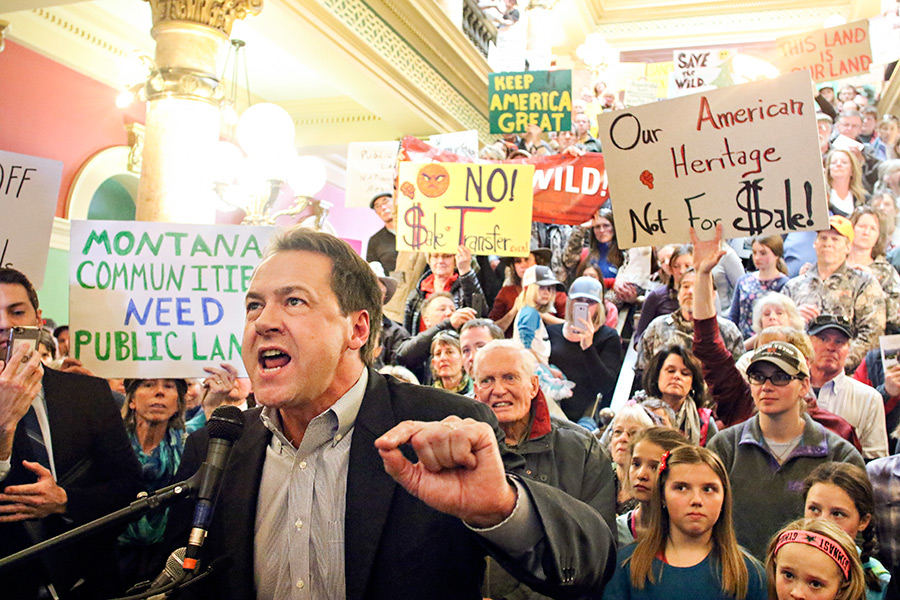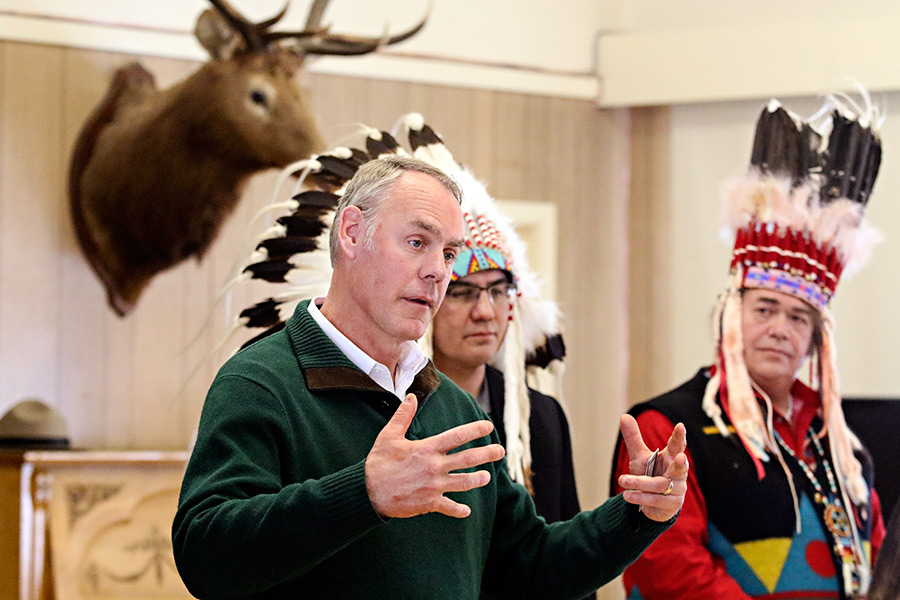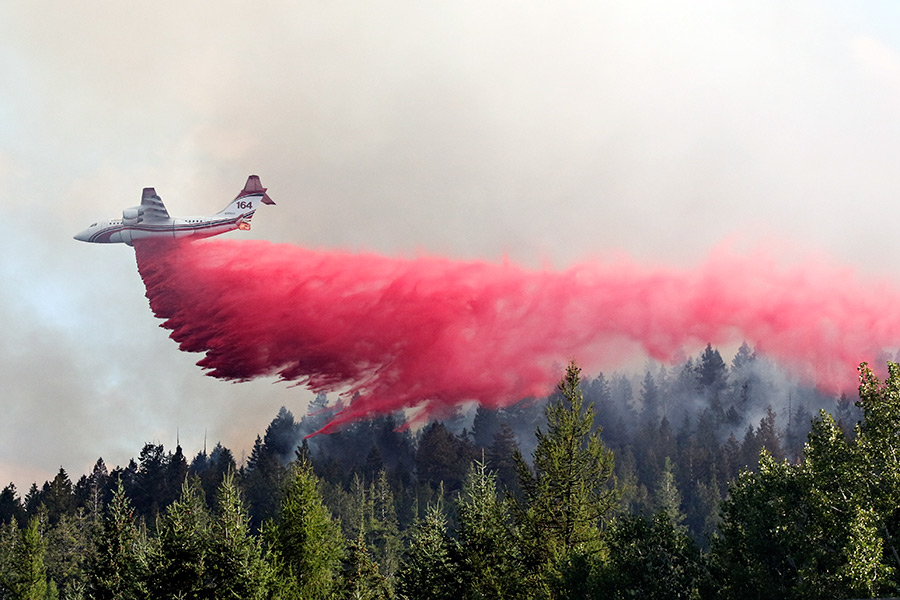Wildfires
The number of large, catastrophic wildfires has increased dramatically in the last decade. Wildfires have consumed millions of acres of forest and destroyed hundreds of homes nationwide on an annual basis in recent years, and the number of wildfires bigger than 1,000 acres has doubled across the West since the 1970s. Six of the worst fire seasons on record in terms of burned acreage have occurred since 2005.
Many of these catastrophic blazes have occurred in the West. Not only do these wildfires threaten lives and property and reshape the landscape, a new report is raising additional concerns about human health threats. A new study published in the Journal of Geophysical Research shows that wildfires emit large amounts of pollutants, making them a significant source of particulate pollution in Western states, although their impact is underestimated by more than a factor of three in emissions inventories.
Government agencies face a sizeable challenge in addressing wildfires. The U.S. Forest Service faces an annual budgetary conundrum in addressing wildfire costs. Two years ago, the agency depleted its firefighting budget by August amid the most expensive fire season in U.S. history. The agency budgeted for $1 billion, but actual costs reached $1.7 billion. It marked the first time the agency spent more than half of its total budget on wildfire suppression. Only 20 years earlier, the agency’s budget devoted only 16 percent of funds to firefighting.

Aquatic Invasive Species
Water bodies from Flathead Lake to Glacier National Park are under siege from aquatic invaders. Zebra and quagga mussels are miniscule aquatic organisms that attach to boats, invade ecosystems and rapidly reproduce, causing deleterious effects that harm native ecosystems and commercial, agricultural and recreational activities.
The first detection of aquatic invasive mussels in Montana surfaced last fall in Tiber Reservoir. Their presence is also suspected in Canyon Ferry Reservoir, the Missouri River below Toston Dam and the Milk River.
As summer arrives, Montana has raced to set up a defense against the mussels by implementing new regulations across the state in an effort to prevent their spread.
Invasive mussels have infested rivers and lakes in 29 states, primarily by clinging to recreational boats and traveling through connected river systems. As filter feeders, mussels efficiently remove food and nutrients from the water column, leaving little or nothing for native aquatic species, including fish. Zebra and quagga mussels promote water clarity by filter feeding. The clearer water allows sunlight to penetrate to the lake bottom, creating ideal conditions for algae to grow.
Across the U.S., mussels are harming municipal and residential drinking water delivery systems, power plant intakes and industrial facilities that use raw surface water. The U.S. Fish and Wildlife Service estimates that if mussels invade the Columbia River system, they could cost hydroelectric facilities alone up to $250-300 million annually.
For example, the infestation of mussels in the Great Lakes has an economic impact of roughly $100 million annually by affecting sport and commercial fishing, water treatment, power generation, industrial facilities using surface water, and tourism, according to an economic analysis in 2012.

Public Lands
Grappling over public lands has erupted into a bitter fight resembling the 1970s and ‘80s, when the so-called Sagebrush Rebellion ignited over federal land control. Debate continues to center on management authority for America’s swath of public lands, the majority of which are in the West. It’s a sensitive subject, especially in Montana, where public lands make up 30 percent of the state, managed in varying areas by the Forest Service, Bureau of Land Management, Fish and Wildlife Service, and the National Park Service.
Claiming these federal agencies are flawed in their management practices, the national Republican Party has adopted as a platform plank the support of transferring certain federal lands to state control.
This runs in the face of many Western voters. The Colorado College State of the Rockies Project released its seventh consecutive Conservation in the West Poll earlier this year, reporting that wide majorities of voters of all stripes in every state except Utah oppose federal land transfers. Among the findings, 58 percent of those polled said they opposed transferring control of federal public lands to states, while 68 percent said they prioritized protecting water, air and wildlife with opportunities for recreation on public land.
In Montana, state and federal agencies, land managers and timber industry officials, including the Montana Wood Products Association, have expressed their opposition to land transfers, largely because they say it is logistically and financially unfeasible for the state to manage more land.
In April, President Donald Trump signed an executive order directing Secretary of the Interior Ryan Zinke, a Whitefish native, to review the designation of dozens of national monuments on federal lands, calling the monuments “a massive federal land grab” by previous administrations. Last week Zinke recommended that the new Bears Ears National Monument in Utah be reduced in size and said Congress should step in to designate how selected areas of the 1.3 million-acre site are managed. A broader review of other national monuments is due in August.

Energy
The Trump administration has declared “the start of a new era” in energy production, vowing to remove environmental regulatory hurdles and revitalize the slumping coal industry, which has a large presence in the West. More than 40 percent of U.S. coal production, or about 450 million tons a year, comes from public lands in Wyoming, Montana and other Western states, and this production brings in more than $1 billion in annual revenue.
Debate continues to swirl around the beleaguered coal industry while the energy market continues to transform and increasingly rely on other forms of energy production, including renewable energy sources.
The Obama administration imposed a three-year moratorium on new coal leases on federal lands in January 2016, saying the program should be modernized to ensure a fair financial return for taxpayers and address climate change.
President Trump announced this spring the rollback of several environmental regulations that have affected the coal industry, particularly Obama’s plan to curb global warming.
Despite Trump’s efforts, experts argue that coal jobs are extremely unlikely to return to past levels. Robert Murray, founder and chief executive of the nation’s largest privately held coal operation, told the Guardian that Trump “can’t bring mining jobs back.”
According to the Mine Safety and Health Administration, the coal mining industry now accounts for fewer than 75,000 U.S. jobs. That’s down from 127,745 in 2008, when Obama was elected, and 250,000 in the 1970s.
By contrast, renewable energy — including wind, solar and biofuels — now accounts for more than 650,000 U.S. jobs, according to the U.S. Energy Department.
Trump’s order initiates a review of the Clean Power Plan, an Obama-era plan that restricts greenhouse gas emissions at coal-fired power plants. The regulation has been the subject of long-running legal challenges by Republican-led states and industry leaders with a stake in oil, coal and gas.
Environmental groups have vowed to fight Trump’s edicts in court.

Outdoor Recreation
Outdoor recreation has become an economic juggernaut, especially in the West. According to a new study by the Outdoor Industry Association, outdoor recreation generates $887 billion in annual consumer spending and supports 7.6 million jobs.
The association estimates that outdoor recreation in Montana supports 64,000 jobs; provides $1.5 billion in wages and salaries; draws $5.8 billion in consumer spending; and generates $403 million in state and local tax revenue. That money comes from tourists and locals alike. “At least 71 percent of Montana residents participate in outdoor recreation each year,” the report states.
How will this influence transfer to public policy? That remains to be seen as the industry gains a foothold as a prominent player in the political landscape. The industry has begun actively promoting policy directives, such as protecting public land and water and investing in federal recreation infrastructure, such as trails and programs.
A recent — and important — example of the industry and its partners throwing their weight around involved the Outdoor Retailer trade show. Organizers of the lucrative trade show decided to move it from Salt Lake City over a disagreement with Utah politicians about their stance on public lands. The show announced the move after previously threatening to leave Utah if Gov. Gary Herbert didn’t stand down from his call for President Trump to rescind the new Bears Ears National Monument.
Montana and Colorado have publicly expressed interest in landing the trade show.
